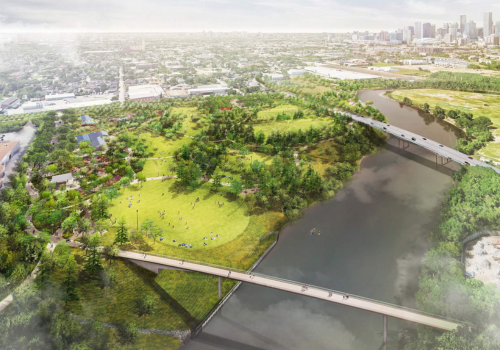Port Houston Chair Renews Call for Widening, Deepening of Ship Channel
Published Nov 21, 2019 by Maggie Martin
Port Houston Chairman Ric Campo laid out his case for why the Houston region must invest in expanding the Houston Ship Channel in front of an audience of nearly 400 business leaders, industry stakeholders and elected officials. Campo delivered his keynote in his first-ever State of the Port address hosted by the Greater Houston Partnership on November 20.
Campo began with a quick overview of the history of Ship Channel, and explained that the concept of widening and deepening the channel isn't new. In the early 1910's, the private sector and federal government each put forward millions in funds to dredge the Ship Channel. Now, said Campo, he's making a similar request.
"Today, I stand on the shoulders of giants, 10 months into my career as Chair of the Port of Houston Authority," he said. "There's a lot of great things happening going forward."
The Port of Houston has been a key economic driver for the Houston region for more than a century and Houston's economic growth is driven in large part by its ability to transport goods in and out of the region. More than 17% of Houston's gross domestic product (GDP) is tied to exports. About 20% of the Lone Star state's GDP is generated through the Port of Houston. Last year, trade through the Port of Houston had nearly $340 billion in direct state economic impact and represents more than 70% of all maritime trade in Texas.
But in order to ensure our economy continues to benefit from the global marketplace, explained Campo, the Houston region must have adequate port and maritime infrastructure to keep pace with growing domestic energy production, petrochemical manufacturing and exports. Trade volume is also increasing and ships are getting wider.
"It's all about public-private partnerships. It's all about a race against economic forces," said the Port Houston chairman.
Campo said the region could have a wider and deeper channel by 2030 if the agency goes through the typical federal government process, but the need is more urgent. "We have to create a mechanism to get it done quicker," urged Campo.
Port Houston has argued it can complete the expansion project by 2024, but in order to do so, dredging must begin by 2021. The organization has called for its partners and other local leaders to ask members of Congress to authorize the project.
"Ric assumed chairmanship of Port Houston earlier this year and now, more than ever, his leadership is vital at this critical moment," said Bob Harvey, President and CEO of the Greater Houston Partnership. "We must invest in widening and deepening the Houston Ship Channel in order to maintain Houston's position as a key global trade corridor. The project isn't without its challenges, but the reality we are facing requires that we take action in order to secure the Houston region's economic future."
"This port was conquered by those who moved forward," said Campo. And now, he said, it's time to do so again.
For more on the Houston Ship Channel expansion project, click here. Learn more about the Port of Houston's trade highlights in the Partnership's 2019 Global Houston report. Learn more about the region's transportation and logistics here.
 The Houston Report
The Houston Report




















